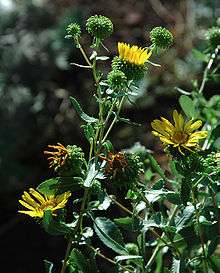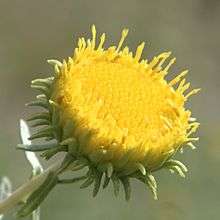Grindelia squarrosa
Grindelia squarrosa, also known as a curly-top gumweed or curlycup gumweed, is a small North American biennial or short-lived perennial plant.[2]
| Grindelia squarrosa | |
|---|---|
 | |
| Curlycup gumweed (Grindelia squarrosa) | |
| Scientific classification | |
| Kingdom: | |
| (unranked): | |
| (unranked): | |
| (unranked): | |
| Order: | |
| Family: | |
| Tribe: | |
| Genus: | |
| Species: | G. squarrosa |
| Binomial name | |
| Grindelia squarrosa | |
| Synonyms[1] | |
|
Synonymy
| |
| Wikispecies has information related to Grindelia squarrosa |
| Wikimedia Commons has media related to Grindelia squarrosa. |

It is native to western and central North America, from British Columbia east to Québec and New England, and south as far as California, New Mexico, Arizona, Chihuahua, and Texas. The species may possibly be naturalized in much of the eastern part of that distribution.[3][4][5][6]
Description
Grindelia squarrosa is often found in disturbed roadsides, streamsides; 700–2,300 metres (2,300–7,500 ft) in elevation. It is a decumbent to erect, much-branched perennial herb of subshrub up to 100 cm (40 inches) tall. The 1.5–7 cm leaves are gray-green, crenate with each tooth having a yellow bump near its tip, and resinous.[5][7]
Grindelia squarrosa produces numerous flower heads in open, branching arrays. Each head usually contains 12-40 yellow ray flowers, though sometimes the rays are absent. These surround many small disc flowers. The plant blooms from July through late September.[5][8][7]
Uses
Grindelia squarrosa is listed by the Lady Bird Johnson Wildflower Center Native Plant Information Network (NPIN) as of "Special Value to Native Bees."[6]
The plant concentrates selenium, and can be toxic when ingested by cattle, humans, and other mammals.[5]
The plant is being explored as a potential source of biofuel due to its high content of mono- and di-terpenes which can be converted to a fuel analogous to kerosene or jet fuel.[12] The plant's adaptation to arid climates makes it an attractive option as its cultivation in desert areas would not compete with traditional food crops.
Native American medicinal plant
The flowers and leaves are used by Great Plains Tribes as a medicinal herb to treat illnesses such as asthma, bronchitis or skin rashes.[6][13][14] The powdered flowers were also once smoked in cigarettes to ease asthmatic symptoms.[15]
It is used as a traditional medicinal plant by Shoshone peoples in various regions.[13] The Gosiute language name for the plant is mu’-ha-kûm.[16] The Lakota language name for the plant is pteíčhiyuȟa.
References
- "Grindelia squarrosa". The Global Compositae Checklist (GCC) – via The Plant List.
- "Grindelia squarrosa". Integrated Taxonomic Information System.
- "Grindelia squarrosa". Natural Resources Conservation Service PLANTS Database. USDA.
- "Grindelia squarrosa". County-level distribution map from the North American Plant Atlas (NAPA). Biota of North America Program (BONAP). 2014.
- Jepson Manual, University of California (TJM2)
- "Grindelia squarrosa". Native Plant Database. Lady Bird Johnson Wildflower Center, University of Texas at Austin.
- Strother, John L.; Wetter, Mark A. (2006). "Grindelia squarrosa". In Flora of North America Editorial Committee (ed.). Flora of North America North of Mexico (FNA). 20. New York and Oxford – via eFloras.org, Missouri Botanical Garden, St. Louis, MO & Harvard University Herbaria, Cambridge, MA.
- Kansas Wildflowers & Grasses
- "Grindelia squarrosa var. quasiperennis". Natural Resources Conservation Service PLANTS Database. USDA.
- "Grindelia squarrosa var. serrulata". Natural Resources Conservation Service PLANTS Database. USDA.
- "Grindelia squarrosa var. squarrosa". Natural Resources Conservation Service PLANTS Database. USDA.
- Neupane, Bishnu P.; Shintani, David; Lin, Hongfei; Coronella, Charles J.; Miller, Glenn C. (2016-11-22). "Grindelia squarrosa: A Potential Arid Lands Biofuel Plant". ACS Sustainable Chemistry & Engineering. 5 (1): 995–1001. doi:10.1021/acssuschemeng.6b02315. ISSN 2168-0485.
- University of Michigan at Dearborn, Native American Ethnobotany Database: Grindelia squarrosa
- Northern Prairie Wildlife Research Center Archived 2006-09-29 at the Wayback Machine
- Niering, William A.; Olmstead, Nancy C. (1985) [1979]. The Audubon Society Field Guide to North American Wildflowers, Eastern Region. Knopf. p. 382. ISBN 0-394-50432-1.
- Chamberlin, Ralph Vary (1911). "The Ethno-botany of the Gosiute Indians of Utah" (PDF). Memoirs of the American Anthropological Association Vol II, part 5. Retrieved 2007-11-12.
External links
- Calflora Database: Grindelia squarrosa (Curlycup gumweed)
- Grindelia squarrosa in the CalPhotos Photo Database, University of California, Berkeley